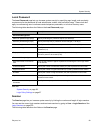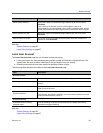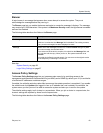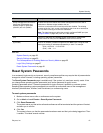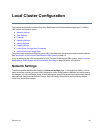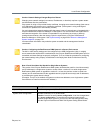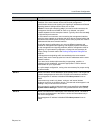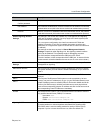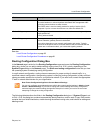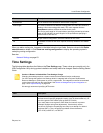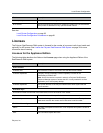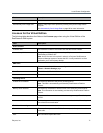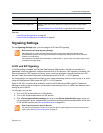
Local Cluster Configuration
Polycom, Inc. 66
Shared Management Network
Settings
The settings in this section apply to the entire system (both servers in
two-server configuration), whether management and signaling are combined
or separate.
Virtual host name Virtual host name and IP address(es) for the system’s management (or
combined) network interface.
For a one-server configuration, these fields are disabled. (Exception: If only
IPv6 is enabled, the system must have two addresses, so a single-server
system must still have a virtual host name and IP address.)
Host names may contain only letters, numbers, and internal dashes
(hyphens), and may not include a domain. The reserved values appserv* and
dmamgk-* may not be used for host names.
The host name is combined with the domain name specified under General
System Network Settings to form the fully qualified domain name (FQDN).
Note: Specify all IPv4 addresses in dotted-decimal form and all IPv6
addresses in colon-hex form.
IPv4
IPv6
Subnet mask IPv4 network mask that defines the subnetwork of the system’s management
or combined interface.
IPv6 prefix length IPv6 CIDR (Classless Inter-Domain Routing) prefix size value (the number of
leading 1 bits in the routing prefix mask) that defines the subnetwork of the
system’s management or combined interface.
IPv4 gateway IP address of the gateway server used to route network traffic outside the
subnet.
Management Link
Name The name of the management network interface (eth0) is not editable, and it
can’t be disabled.
The eth0 interface corresponds with the GB1 jack on the server.
Enable
Auto-negotiation Turn on Auto-negotiation or set Speed and Duplex manually.
Note: Auto-negotiation is required if your network is 1000Base-T. Don’t select
10000 unless you’re certain your hardware platform supports it.
Speed
Duplex
Show Link Details Click to see details about link settings and information. This information may
be useful to Polycom Global Services when troubleshooting a network issue.
LAN Security Settings Caution: In a network that requires 802.1x authentication for servers (this is
rarely the case), incorrect settings in this section and, if applicable, lack of the
proper certificate(s) can make the system unreachable. Recovering from this
situation requires connecting a laptop to the system using a crossover cable
in order to access it.
Enable 802.1x Enables the system to authenticate this network interface to the LAN.
Depending on the authentication method, the access credentials required
may be either a user name and password (specified below) or a security
certificate.
User name The user name with which the system may authenticate this interface.
Field Description



